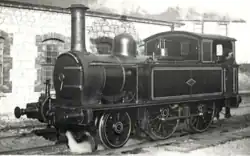 CMDR 2-4-0T beside Capwell Cork engine shed | |
| Overview | |
|---|---|
| Dates of operation | 1866–1953 |
| Successor | Great Southern Railways (GSR) |
| Technical | |
| Track gauge | 5 ft 3 in (1,600 mm) |
| Length | 24 miles 13 chains (38.9 km) |
.jpg.webp)
The Cork and Macroom Direct Railway (CMDR) was an Irish gauge (5 ft 3 in (1,600 mm)) railway in Ireland which ran the 24 miles (39 km) from Cork to Macroom.
History
It was incorporated in 1861[1] and was chaired by Sir John Arnott and Joseph Ronayne. The engineer for the scheme was Sir John Benson.
Construction work started in 1863. The line cost £6,000 per mile (equivalent to £591,347 in 2021)[2] and there were five stations on the 24 miles 13 chain length.[3] It opened on 12 May 1866 and utilised the Cork, Bandon and South Coast Railway terminus at Albert Quay.
The company wanted independence from the Cork, Bandon and South Coast Railway which was charging £2,000 per annum for the privilege, so it built a new terminus on Summerhill South road fed by a link from Ballyphehane Junction. Cork Capwell railway station cost £28,000 (equivalent to £3,028,796 in 2021),[2] and opened in September 1879. The link with the CBSCR was severed as the CMDR wished to remain independent however they were forced to re-open it by the Irish Railways Executive Committee in 1918.[4]
In 1925, the Cork and Macroom Direct Railway was amalgamated into the Great Southern Railways (GSR) along with other Irish railway companies. The CMDR whilst small was modestly profitable and had attempted to remain independent even again severing their link to the rest of the network but in the end their attempts were fruitless.[4]: 174
Powers to extend the CMDR to Kenmare had been granted but were never exercised.[5]
Closure
The Cork Capwell terminus closed on 2 March 1925, and trains reverted to the original terminus at Albert Quay. In 1929, the Capwell station buildings were acquired by the Irish Omnibus Company. The last regular passenger train was operated in 1935 and the line eventually closed to all remaining traffic in 1953 when part of its route was flooded for the creation of the Lee reservoir.
Rolling Stock
Locomotives
The CMDR had five locomotives at the time absorption into the GSR.[4]: 174–176, 380
| CMDR No. | GSR No. | GSR Type | Type | Builder | Works No. | Introduced | Withdrawn | Notes |
|---|---|---|---|---|---|---|---|---|
| 1 | 487/G5 | 2-4-0T | Dübs and Company | 17 | 1865 | Not passed to GSR in 1925 | ||
| 2 | 487 | 487/G5 | 2-4-0T | Dübs and Company | 18 | 1865 | 1928 | |
| 3 | 488 | 487/G5 | 2-4-0T | Dübs and Company | 235 | 1867 | 1934 | |
| 4 | 488 | 487/G5 | 2-4-0T | Dübs and Company | 1505 | 1881 | 1928 | |
| 5 | 490 | 490/I2 | 0-6-2T | Andrew Barclay Sons & Co. | 1022 | 1905 | 1935 | |
| 6 | 491 | 491/F5 | 2-4-2T | Vulcan Foundry | 1315 | 1914 | 1934 | Built 1891 for Waterford, Limerick and Western Railway |
Carriages and Wagons
At the time of the 1925 amalgamation the CMDR passed on 27 coaches and 117 wagons to the GSR.[5]
Livery
In 1903 locomotives were light green with black and yellow lining. By the 1925 amalgamation they were black with red lining.[4]: 174
Incidents
On 8 September 1878, there was a derailment east of Ballincollig that resulted in 5 deaths and 70 injuries. This incident resulted in significant financial outlay for the company for several years.[6]
Further reading
- Creedon, Colm (2015). Cork & Macroom Direct Railway Album (PDF). Colm Creedon Collection (digital). Cork: County Library. Archived (PDF) from the original on 7 December 2017.
References
- ↑ A history of railway letter stamps: describing all varieties issued by the railway companies of Great Britain and Ireland under the authority of the postmaster-general. Herbert L'Estrange Ewen, 1901
- 1 2 UK Retail Price Index inflation figures are based on data from Clark, Gregory (2017). "The Annual RPI and Average Earnings for Britain, 1209 to Present (New Series)". MeasuringWorth. Retrieved 11 June 2022.
- ↑ Bradshaw's railway manual, shareholders' guide, and official directory. W. J. Adams, 1864
- 1 2 3 4 5 Clements, Jeremy & McMahon, Michael (2008). Locomotives of the GSR. Newtownards: Colourpoint Books. ISBN 978-1-906578-26-8.
- 1 2 3 "Other Cork railways (CMDR, TCLR)". irishrailwayana. Cork and Macroom Direct Railway. Archived from the original on 10 March 2017. Retrieved 15 April 2018.
- ↑ "Pages 39 to 44. Railway company: 1878; Cork and Macroom Direct Railway. Notes: Report..." The National Archives, Kew. Notes: Report on a fatal accident that occurred on 8 September 1878, near Ballincollig, to a passenger train which left the rails. Retrieved 15 April 2018.